The Millennium Development Goals of the United Nations The Millenium Development Goals were the underlay of Race Against Time. Goal 7 - Ensure Environmental Sustainability, subdivides into targets,
one of which is "Halve, by 2015, the proportion of people without
sustainable access to safe drinking water and basic sanitation." From
the current report UN MDG 2008 Report, 1.9 billion people have gained access to clean water since 1990. However
now that half the world now live in cities, 1/3 of the urban population
live in slum conditions and clean water and sanitation again is an issue.
If we are to reach the 2015 goal we need to redouble our efforts, despite
the world's economic distress.
When the St. John the Evangelist people visited us, we were told the unexpected answer to the question they raised to the people in Malawi of what did they most need. It was clean water. And this led to their Mphatso Pure Water Project Malawi. |
 |
| UNESCO WATER The UNESCO Water Portal is intended to enhance access to information related
to freshwater available on the World Wide Web. The site provides links to the current UNESCO and UNESCO-led programmes
on freshwater and will serve as an interactive point for sharing, browsing
and searching websites of water-related organizations, government bodies
and NGOs, including a range of categories such as water links, water events,
learning modules and other on-line resources. |
 |
| WHO works on aspects of water, sanitation and hygiene where the health burden
is high, where interventions could make a major difference and where the
present state of knowledge is poor |
 |
| The World Water Forum is the largest multi-stakeholder process of the water community in the world. It involves directly several thousands of stakeholders representing a great variety of situations, cultures, perspectives, responsibilities. It aims to turn information into political committment. The 5th World Water Forum was just held in Istanbul, Turkey in March 2009. Check out some of the many reports. Mayors from cities the world over published a manifesto claiming public control of water, and setting out priorities in the cities in The Instanbul Water Consensus. |
 |
|
| Slow Sand Filter. Wikipedia entry on sand filters show this to be a long standing bit of
engineering is still in use to filter the water supply of most of Europe.
It was the insight of Dr. Manz of Calgary to adapt this method to supply
clean water for a community to a means of supplying clean water for a family. |
 |
manswaterinfo.ca Dr. David H. Manz is the engineer at the University of Calgary that wondered
in 1988 what might help those millions in the world that have contaminated
water. This site is that successful story and how over 200,000 BioSandFilters
have been made. Check out the pictorial history of its development at the
engineering department of the university. LINK.
"The objective is to provide as much useful guidance as possible to
all of the organizations and individuals involved with or interested in
implementing BSF projects, using the BSF technology, evaluating BSF technology
and its implementation, research and development of the BSF technology
(at least as it pertains to humanitarian applications), funding BSF activities,
regulatory bodies concerned with certifying BSF technology and any other
activity pertaining to the successful use of the BSF technology worldwide."
In addition to the family size filter, Dr. Manz has now designed village
size filters using his new invention, The Low Operating Head Polishing Sand Filter. Again his design is industrial in design and resource and cost effective.
|
 |
| A Kenyan Thankyou |
|
| CAWST - Centre for Affordable Water and Sanitation Technology. The non-profit organization reaches out to non-governmental organizations
in the developing world to show them that there are many simple, low-cost
technologies available to ensure populations have access to an adequate
water supply. As the CEO and president of CAWST, Dow Baker is credited for bringing the Biosand water filtration system to more than 20,000 homes in 30 developing nations. Their efforts were recently acknowledged by the United Nations, which added CAWST to the list of top 40 best practices in improving the living environment around the world. (Including the Malawi project). Dow was a student of Dr. Manz. Check out the 9 papers delivered on Household Water to the recent world conference in Istanbul. LINK |
 |
| Potters for Peace. is a U.S. based nonprofit, founded in Nicaragua in 1986. We work primarily
in Central America although our water filter projects are worldwide. The
vast majority of potters in Central America are rural women and the core
work for Potters for Peace has always been assisting these hard working
people to earn a better living. Every day 5.000 children die due to unsanitary
water, (WHO 2005). Since 1998, Potters for Peace has been assisting in
the production worldwide of a low-tech, low-cost, colloidal silver-enhanced
ceramic water purifier (CWP). Field experience and clinical test results
have shown this filter to effectively eliminate approximately 99.88% of
most water born disease agents. The ceramic filter is another long-standing
method to clean water. Again, the genius is in adapting it to the scale
and cost of a families need. |
 |
| Clay Pot Filter. Caring this even further, an Australian inventor claims that a handful
of clay, yesterdayís coffee grounds and some cow manure are the ingredients
that could bring clean, safe drinking water to much of the third world.
The simple new technology, developed by ANU materials scientist Mr Tony
Flynn, allows water filters to be made from commonly available materials
and fired on the ground using cow manure as the source of heat, without
the need for kiln. The filters have been tested and shown to remove common
pathogens including E-coli. It was developed in East Timor where the clay
was too fine to pass water. |
 |
| Doulton Ceramic Filters. John Doulton founded his first pottery in 1815 at Lambeth, England on
the banks of the Thames river. Doulton placed equal emphasis on industrial
applications for ceramic technology. As early as 1827, this fine china
manufacturer was in the water treatment business, using various earth and
clay materials in the first Doulton water filters. In 1835, Queen Victoria
recognized the present health dangers in her drinking water and commissioned
Doulton to produce a water filter for the Royal household. They still make
and market their water filter products of diatomaceous earth and coilloidal
silver. |
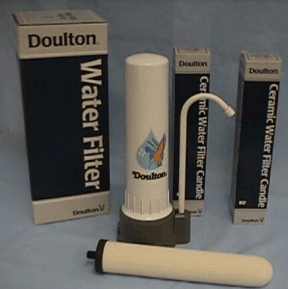 |
Comparative Analysis of the Filtron and Biosand Water Filters University
of Victoria.
"Perhaps the best solution is to combine the two filters, first pouring
the source water through the biosand filter, then running a portion of
that water through the Filtron prior to drinking. "Improved water"
from the biosand filter could be used for bathing and food preparation,
and another 4-8 liters of "improved water" filtered with the
Filtron to be used for drinking." |
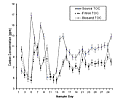 |
CMS - Church Mission Society (Anglican - Oxford)
These folks are determined to take the commmission of Jesus seriously,
and from Oxford England mount a world wide mission of practical assistance.
Clean Water for All, CMS sub-site. "More than 1,000,000,000 people donít have safe water to drink but
it has been recently discovered that they easily could have, if they knew
how to make a clay pot biological sand filter. Itís a home made filter
that poor people can afford so it will make them feel richer and more able
as they make their own filter with materials they already have access to.
It will therefore strengthen the values that help people who are vulnerable
to consumerist aspects of development: Valuing the responsibility to overcome
our own problems; valuing what we already have; valuing knowledge we can
share with others; our health."
Home Made Biological Filter. Click poster image right to see full size. If ever a picture was worth
a thousand words, this one is. It communicates everything necessary.
They also have figured a near zero cost Desalination Unit. Here's a link to the story and the pictures.
|
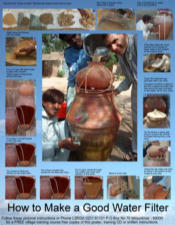 |
Living Waters for the World.
American Presbyterians based in Franklin, Tenn., sponsors Clean Water U as part of its Hunger Network. After learning about the dire need for
water purification, Howie, a former clinical psychologist, worked with
several Presbyterian engineers to develop a system that uses about $2,500
worth of materials (plus the cost of a tiny cement-block building) to filter,
ozonate and chlorinate enough drinking water for a village of 500. For more of the story. |
|
http://youtube.com/watch?v=tv4NDTVQe9w
http://youtube.com/watch?v=LPAWuws7qMM
http://www.youtube.com/watch?v=EU3rRiWsRE0&NR=1
http://www.youtube.com/watch?v=puUid4LZCwMhttp://youtube.com/watch?v=aLKwH68LjnM |
Some Videos |
| BushProof Sustainable Products. A firm supporting NGO's in helping the world's water issues. Much in the
way of detailed plans. Excellent product on the small and moderate size.
A UK agency birthed in Africa. They have developed a similar filter to
the Manz design, one that is circular rather than rectangular, and have
similarly supported it to the fullest. Complete Plans are on-line. - amazing level of detail and range of information on their ideas products
and services. |
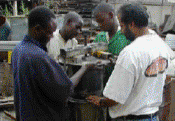 |
|
The Canzee pump is of ingenious simplicity: it has no conventional piston or seals. It
contains no significantly wearing parts and the pump needs no maintenance.
The few parts that do eventually break down are very easily repaired. Ideal
for installation on shallow hand dug or jetted wells, the pump is robustly
constructed and lifts water from at least 10 meters. Two designs are available:
for villages or individual households.
Another remarkable bit of functional dependable cheap engineering from
BushProof. The design uses two lengths of PVC pipe that slide inside each
other. Water lubricates it. The valve at the bottom is a piece of rubber
cut from an old inner tube. They work years with minor service.
|
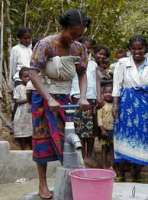 |
| Ferro Cement Jar. University of Warwick engineers have devised a plan for a large cummunal
concrete water collection and filtering jar. Unbelievable in its cheap
and practical construction design. You'll love what they used for the "mold".
"This manual gives guidelines for the manufacture of a 500 litre Ferro-cement
Jar, which was based on a jar built at Kyera Farm, Mbarara, Uganda during
June and July 2000. The jar basically consists of a brick plinth, a Ferro-cement
shell, and a filter basin. This is a well proven technology that has been
successful in Thailand, these were traditionally made from a rendered bamboo
mould but now they use chicken mesh, 10 million jars were built in Thailand
between 1985 and 1992." |
 |
|
















